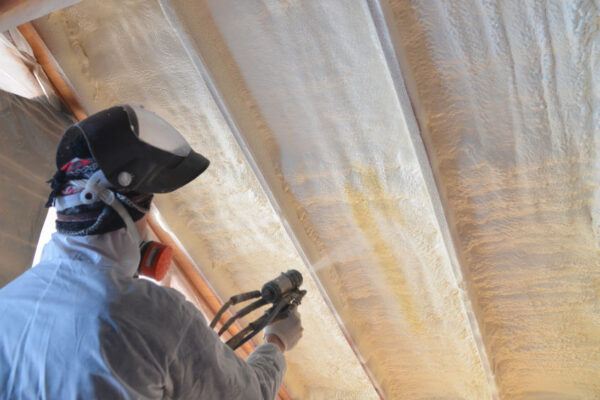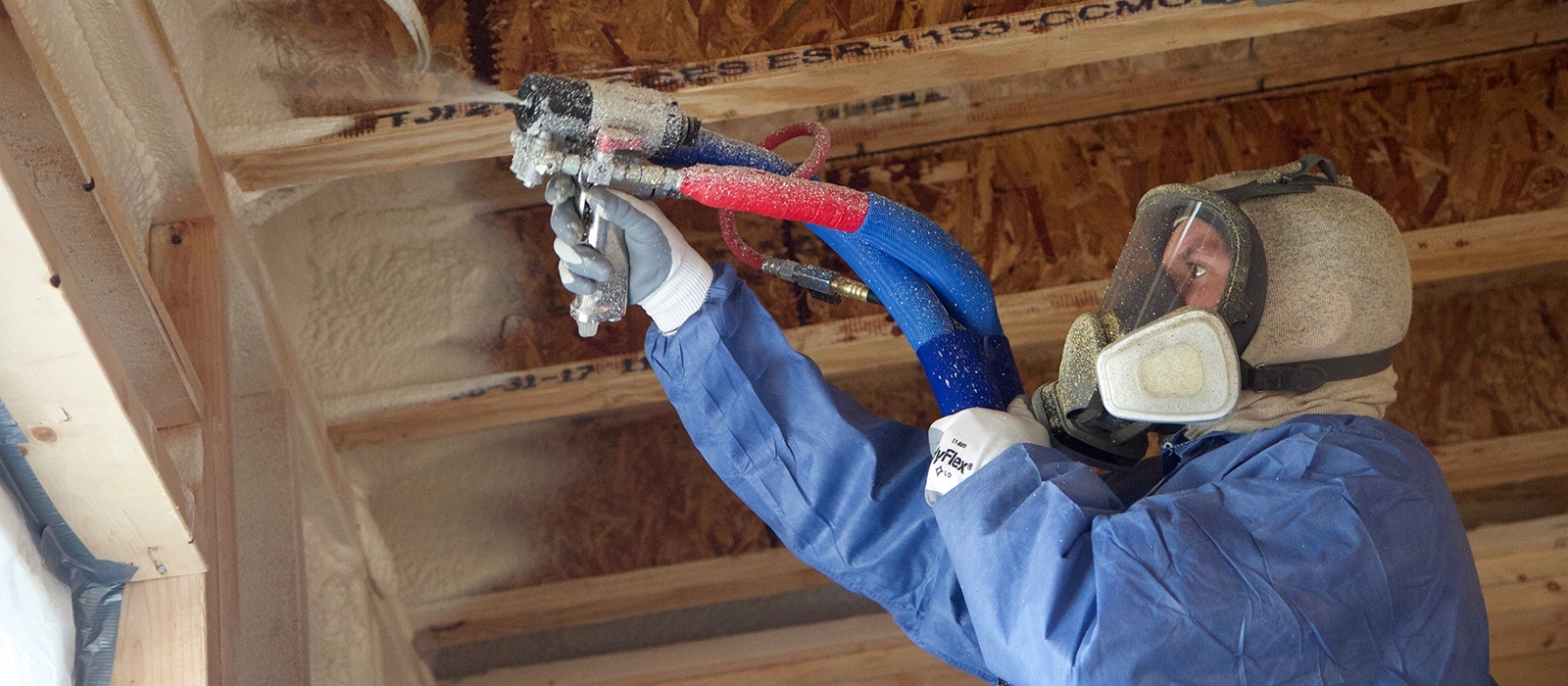Typical Misconceptions About Spray Foam: Debunking the Misconceptions
Wiki Article
Spray Foam: The Ultimate Remedy for Air Sealing and Insulation
Spray foam insulation has arised as a leading remedy for reliable air sealing and thermal insulation, supplying a distinct combination of properties that establish it apart from typical approaches. Comprehending the complete scope of its benefits, installment procedures, and comparisons with various other insulation kinds is important for making notified decisions.What Is Spray Foam?
Spray foam is a versatile insulation product that integrates the principles of air securing and thermal resistance to improve energy performance in structures. Composed primarily of polyurethane or other comparable substances, spray foam is applied as a liquid that increases upon contact with surfaces, developing a strong, continuous layer of insulation. This special building enables it to fill voids, fractures, and voids that typical insulation materials might forget, providing a premium air seal.There are two primary kinds of spray foam: open-cell and closed-cell. Open-cell spray foam is lighter and a lot more flexible, using exceptional audio absorption and a reduced R-value per inch - Spray Foam. In contrast, closed-cell spray foam is denser, providing a greater R-value, moisture resistance, and added architectural integrity to developing components
The application procedure usually entails specialized tools, guaranteeing a smooth application that abides by various substrates, consisting of steel, timber, and concrete. This flexibility makes spray foam suitable for both brand-new building and constructions and retrofitting existing structures. Its ability to develop an impermeable barrier significantly adds to reducing energy usage and boosting interior air quality, consequently making it a recommended choice among property owners and home builders alike.
Advantages of Spray Foam Insulation
One of the most considerable benefits of spray foam insulation is its remarkable ability to produce a constant air obstacle, which properly reduces energy loss. Unlike traditional insulation materials, spray foam broadens to fill up splits and spaces, guaranteeing that air leak is drastically reduced. This characteristic not just enhances energy efficiency yet also brings about lower utility bills with time.
In addition, spray foam insulation provides exceptional thermal resistance, adding to an extra stable indoor setting. Its high R-value per inch enables effective insulation in restricted rooms, making it optimal for attics, wall surfaces, and crawl rooms. Additionally, the moisture-resistant properties of spray foam help stop mold and mildew and mildew growth, advertising healthier living problems.
Another important advantage of spray foam insulation is its sound-dampening top qualities (Spray Foam). It efficiently decreases sound transmission between rooms, developing a quieter and more comfortable home environment. The resilience of spray foam additionally attracts attention, as it does not sag or clear up with time, maintaining its performance throughout its lifespan
Exactly How Spray Foam Functions
Recognizing how spray foam insulation works is necessary for valuing its performance in air sealing and thermal resistance. Spray foam insulation consists of two main parts: isocyanate and polyol material. When these elements are mixed, they undergo a chemical reaction that creates the product to increase quickly, producing a dense foam that loads gaps, cracks, and cavities.As the foam broadens, it complies with surfaces, developing a closed seal that substantially decreases air seepage. This characteristic makes spray foam insulation extremely reliable at stopping drafts and dampness infiltration, which can bring about energy loss and damage with time. In addition, the closed-cell version of spray foam provides remarkable thermal resistance because of its stiff structure, efficiently reducing heat transfer.
The unique residential properties of spray foam enable it to satisfy irregular surfaces, guaranteeing detailed insurance coverage and a seamless obstacle. Therefore, spray foam insulation not only improves power efficiency but additionally adds to enhanced indoor air top quality by decreasing the build-up of irritants and pollutants. Eventually, comprehending the technicians behind spray foam emphasizes its duty as a remarkable selection for insulation and air securing in both commercial and household applications.
Installment Refine Overview

Before installation, the area needs to be appropriately cleaned up and prepped, making certain that surface areas are totally free from dirt, dampness, and debris. This step is vital due to the fact that impurities can jeopardize attachment and general efficiency. As soon as the location is prepared, the application involves mixing both parts of the spray foam, which increases upon get in touch with and loads spaces efficiently.
Trained experts need to conduct the installment, using specialized equipment to guarantee consistent protection and ideal thickness. Safety safety measures, including using protective equipment and making sure correct air flow, are important throughout this procedure. After application, the foam usually remedies promptly, forming a strong obstacle that boosts power effectiveness.
Comparing Spray Foam to Standard Insulation
When evaluating insulation options, spray foam insulation attracts attention in contrast to conventional products such as fiberglass and cellulose. One of the main benefits of spray foam is its premium air securing capabilities. Unlike fiberglass and cellulose, which can enable air seepage, spray foam broadens upon application, filling gaps and crevices to develop a closed seal. This results in boosted power efficiency, as much less warmed or cooled air escapes the home, leading to lower utility costs.In addition, spray foam gives a greater R-value per inch than conventional insulation types, using even more efficient thermal resistance in a thinner profile. This this post characteristic is especially advantageous in rooms with limited dental caries deepness. In addition, spray foam is immune to moisture and mold development, which can be a considerable worry about cellulose and fiberglass, especially in moist environments.
Nevertheless, spray foam insulation normally lugs a higher upfront price than its conventional equivalents. Property owners have to weigh this first investment against lasting energy financial savings and efficiency advantages. Inevitably, while both insulation kinds serve their objective, spray foam becomes a more innovative solution for modern insulation demands, particularly in terms of air securing and thermal effectiveness.

Verdict
In summary, spray foam insulation represents a highly efficient option for accomplishing optimum air sealing and thermal resistance. Its unique properties, including wetness resistance and audio dampening, make it suitable for different applications in both brand-new constructions and retrofitting projects (Spray Foam). The initial expenses may be higher compared to traditional insulation products, the long-lasting benefits, such as substantial energy savings reference and boosted indoor air quality, warrant the investment and emphasize its value in modern structure methods.Spray foam insulation has actually arised as a leading service for effective air securing and thermal insulation, using a special combination of residential properties that set it apart from traditional techniques.Spray foam is a versatile insulation product that incorporates the principles of air sealing and thermal resistance to improve power effectiveness in buildings.When assessing insulation alternatives, spray foam insulation stands out in comparison to standard materials such as fiberglass and cellulose. Ultimately, while both insulation kinds offer their objective, spray foam arises as a more advanced option for modern-day insulation needs, specifically in terms of air securing and thermal efficiency.
In recap, spray foam insulation stands for a highly efficient remedy for achieving ideal air securing and thermal resistance.
Report this wiki page